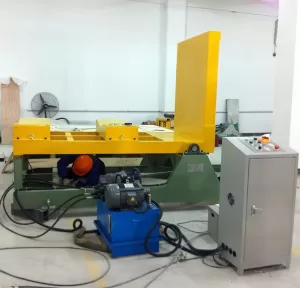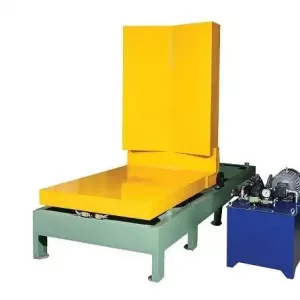Understanding Hydraulic Tilters and Upenders: Enhancing Safety and Efficiency in Material Handling
In demanding industrial environments, handling heavy, bulky, or awkwardly shaped loads presents significant challenges. Safely and efficiently changing the orientation of these items is crucial for various processes, from manufacturing and assembly to storage and shipping. Hydraulic tilters and hydraulic upenders are powerful material handling solutions designed specifically for these tasks, using controlled hydraulic force to manipulate loads with precision.
Demonstration of a hydraulic upender performing a 90-degree tilt operation.
Key Specifications of the Demonstrated Unit
The video showcases a specific hydraulic upender model. Understanding its specifications provides context for its capabilities:
- Power Source: 5.5 Kw hydraulic station – Provides the necessary force for movement.
- Maximum Load Capacity: 2 Tonnes (2T) – Indicates the weight limit the machine can safely handle.
- Working Table Configuration: Flat table + V-shape table – Offers versatility for supporting different load types (e.g., flat items vs. cylindrical coils).
- Base Height: 200mm – Relates to the machine's profile and integration into workflows.
- Hydraulic Cylinder Outer Diameter: 180mm – A factor in the machine's lifting power and durability.
- Control Method: Control panel + Remote control – Allows for flexible operation, both near the machine and from a distance for enhanced visibility or safety.
- Manufacturer: FHOPE – The provider of the equipment shown.
The Power Behind the Movement: Hydraulic Systems
At their core, both hydraulic tilters and upenders rely on the principles of hydraulics. A hydraulic system uses incompressible fluid (typically oil), pressurized by a pump driven by an electric motor (like the 5.5 Kw station mentioned), to actuate cylinders. These cylinders convert hydraulic pressure into linear force, which is then mechanically translated into the tilting or upending motion of the load-bearing platform. This method provides significant force, smooth control, and reliable operation suitable for heavy industrial loads.
Hydraulic Tilter vs. Hydraulic Upender: What's the Difference?

- Hydraulic Tilter: This equipment is designed to tilt a load through a range of angles, often less than or equal to 90 degrees. The primary purpose is typically to provide ergonomic access to the load for assembly, maintenance, or processing, or to discharge contents from a container.
- Hydraulic Upender (or Inverter): This machine is specifically designed to change a load's orientation, most commonly by 90 degrees (from horizontal to vertical or vice-versa) or sometimes 180 degrees (inverting). They are essential for tasks like rotating steel coils, paper rolls, molds, or fabricated assemblies from one orientation to another for subsequent processing or transportation. The unit in the video performs a 90-degree upending action.
Core Features Driving Performance and Safety
Modern hydraulic tilters and upenders incorporate features designed for efficiency, safety, and adaptability:
- Versatile Load Platforms: Platforms can be flat, feature V-shapes for cylindrical loads, or include conveyors for integration into automated lines. Adjustable sizes accommodate diverse product dimensions. Adding descriptive alt text to images of these platforms online improves accessibility and SEO.
- Precision Control Systems: Programmable Logic Controllers (PLCs) allow for precise angle control, repeatable cycles, and integration with other factory systems. Remote controls enhance operator safety and visibility.
- Secure Load Handling: Automatic clamping, locking mechanisms, or specialized fixtures secure the load during the tilting or upending process, preventing dangerous shifts or falls.
- Robust Safety Mechanisms: Features often include emergency stop buttons, safety guards or light curtains, hydraulic velocity fuses (to prevent sudden drops in case of hose failure), and overload protection. Compliance with safety standards like those from OSHA is crucial ([Link to relevant OSHA or safety standard body - placeholder for external authoritative link]).
- Durability and Reliability: Built with heavy-gauge steel and robust components, these machines are designed for longevity in demanding industrial settings with regular maintenance.
Where are Hydraulic Tilters and Upenders Used?
These machines are indispensable in numerous sectors:
- Steel Industry: Handling and rotating heavy steel coils and plates.
- Paper Mills: Upending large paper rolls.
- Manufacturing: Positioning engine blocks, large assemblies, or molds for work or inspection.
- Logistics & Warehousing: Tilting containers for loading/unloading, rotating pallets.
- Foundries: Manipulating heavy castings or molds.
- Construction: Handling precast concrete sections or pipes.
Prioritizing Safety in Tilting and Upending Operations
While these machines enhance safety compared to manual methods, safe operation is paramount. This includes:
- Ensuring loads are within the rated capacity.
- Properly securing the load before operation.
- Regular inspection and maintenance of hydraulic systems and safety features.
- Comprehensive operator training on procedures and emergency protocols.
- Maintaining a clear operating area.
Investing in Efficient and Safe Material Handling

- Reduce the risk of musculoskeletal injuries associated with manual handling.
- Increase throughput by speeding up orientation changes.
- Minimize damage to valuable products during handling.
- Enable smoother integration with other automated processes.
Choosing the right hydraulic tilting or upending equipment requires careful consideration of load characteristics, required angles, cycle times, and the operating environment. However, when properly specified and implemented, they become essential tools for streamlining operations in heavy industry.